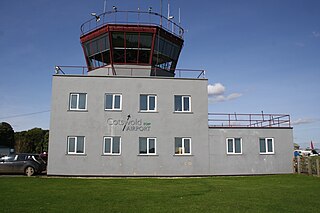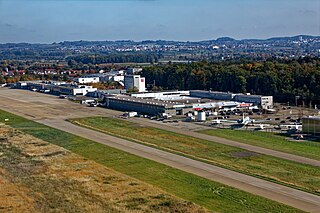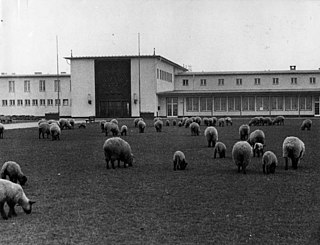
Baden-Baden is a spa town in the state of Baden-Württemberg, south-western Germany, at the north-western border of the Black Forest mountain range on the small river Oos, ten kilometres east of the Rhine, the border with France, and forty kilometres north-east of Strasbourg, France.

Biggin Hill is a district on the south-eastern outskirts of Greater London, England, within the London Borough of Bromley. Prior to 1965, it was in the administrative county of Kent. It is situated beyond London's urban sprawl, 15.2 miles (24.5 km) south-southeast of Charing Cross, with Keston to the north, New Addington to the north-west and Tatsfield, in the neighbouring county of Surrey, to the south. At the 2011 Census, Biggin Hill had a population of 9,951.

Eindhoven Airport is an airport located 7.6 km (4.7 mi) west of Eindhoven, Netherlands. In terms of the number of served passengers it is the second largest airport in the Netherlands, with 6.2 million passengers in 2018. The airport is used by both civilian and military traffic.

Aberdeen International Airport is an international airport, located in the Dyce suburb of Aberdeen, Scotland, approximately 5 nautical miles northwest of Aberdeen city centre. A total of just under 3.1 million passengers used the airport in 2017, an increase of 4.6% compared with 2016.

Bremen Airport is the international airport of the city and state of Bremen in Northern Germany. It is located 3.5 km (2.2 mi) south of the city and handled 2.66 million passengers in 2015. It mainly features flights to European metropolitan and leisure destinations.

Karlsruhe/Baden-Baden Airport is the international airport of Karlsruhe, the second-largest city in the German state of Baden-Württemberg, and also serves the spa town of Baden-Baden. It is the state's second-largest airport after Stuttgart Airport, and the 18th-largest in Germany with 1,110,500 passengers as of 2016 and mostly serves low-cost and leisure flights.

Roosevelt Field is a former airport, located 2.3 miles (3.7 km) east-southeast of Mineola, Long Island, New York. Originally called the Hempstead Plains Aerodrome, or sometimes Hempstead Plains field or the Garden City Aerodrome, it was a training field for the Air Service, United States Army during World War I.

Bowman Field is a public airport five miles (8.0 km) southeast of downtown Louisville, in Jefferson County, Kentucky. The airport covers 426 acres (172 ha) and has two runways. The FAA calls it a reliever airport for nearby Louisville International Airport.

Groningen Airport Eelde is a minor international airport in the northeastern Netherlands. It is located near Eelde in the Province of Drenthe, 4.8 nautical miles south of the City of Groningen in the Province of Groningen. In 2015, the airport handled 220,710 passengers. The airport is also the home base of the KLM Flight Academy, Noord Nederlandse Aero Club (NNAC) and General Enterprises.

Brighton City Airport, also commonly known as Shoreham Airport, is located in the parish of Lancing in West Sussex, England. It has a CAA Public Use Aerodrome Licence that allows flights for the public transport of passengers or for flying instruction.

Cotswold Airport is a private general aviation airport, near the village of Kemble in Gloucestershire, England. Located 4.5 NM southwest of Cirencester, it was built as a Royal Air Force (RAF) station and was known as RAF Kemble. The Red Arrows aerobatics team was based there until 1983. Today it is used for the storage and recycling of retired airliners, as well as flying schools, clubs, and industry.

Wigram Aerodrome is located in the Christchurch suburb of Sockburn, later to be split-suburb of Wigram and now split again as Wigram Skies. It was gifted by Sir Henry Wigram for the Canterbury (NZ) Aviation Company on 20 September 1916 and originally named Sockburn Airport. In 1923 that was then gifted to the Crown as a Royal New Zealand Air Force base. Charles Kingsford-Smith made the first Trans-Tasman flight from Sydney to Wigram on 10 September 1928.

Mannheim City Airport is a minor regional airport serving the German city of Mannheim. It is mainly used for general aviation.

Friedrichshafen Airport is a minor international airport 1.9 miles (3 km) north of Friedrichshafen, Germany, on the banks of Lake Constance. It is the third biggest airport in the German state of Baden-Württemberg after Stuttgart and Karlsruhe/Baden-Baden and served 559,985 passengers in 2015. Friedrichshafen features flights to European metropolitan and leisure destinations. Due to its proximity to the Austrian Alps it is also heavily used during the winter by skiing tourists.

Barrow/Walney Island Airport is located on Walney Island, 1.5 NM northwest of the centre of Barrow-in-Furness, Cumbria, England. The airport is owned by BAE Systems, who operate private communication flights to locations across the United Kingdom and expanded the airport with new infrastructure and terminal buildings in 2018. The Lakes Gliding Club also operates out of the airport.

Karlsruhe Hauptbahnhof is a railway station in the German city of Karlsruhe. The station is classified as a Category 1 station, as it is a major hub where several railways connect.

Evans Head Memorial Aerodrome is a heritage-listed airport in Evans Head, Richmond Valley Council, New South Wales. The airport is approximately 1 km (0.62 mi) north of the village. During World War II it was Royal Australian Air Force (RAAF) Station Evans Head supporting RAAF No 1 Bombing and Gunnery School (1BAGS) and subsequently the RAAF No 1 Air Observers School. At the height of operations there were three asphalt runways and one grass strip. Only a single asphalt strip is still in use by private aviation. It was added to the New South Wales State Heritage Register on 22 November 2002.

Dijon-Longvic Air Base was a French Air Force air base. The airfield is located approximately 2 miles (3.2 km) east-southeast of Longvic; about 165 miles (266 km) southeast of Paris. Operating as a joint civilian base, it is today used as a commercial airport named Aéroport Dijon-Bourgogne.

Baden-Baden station is the most important of the three railway stations in the city of Baden-Baden in the German state of Baden-Württemberg. It is regularly served by local and long distance trains operated by Deutsche Bahn. It is also the served by two lines of the Karlsruhe Stadtbahn, operated by Albtal-Verkehrs-Gesellschaft. The station is located at chainage 105.3 km on the Rhine Valley Railway in the Baden-Baden district of Oos. Until 1977, it was also the starting point of a branch line to the centre of Baden-Baden.

The Butzweilerhof is the former civil airport of Cologne. It was established as a training airfield in 1912 and saw airline service from 1922 until the 1950s. It was replaced by the Cologne Bonn Airport. The airport buildings from 1935-36 are listed monuments and a rare example of airport architecture from the Interwar Period. From 1951 to 1967 it was operated by the Royal Air Force as RAF Butzweilerhof.



























